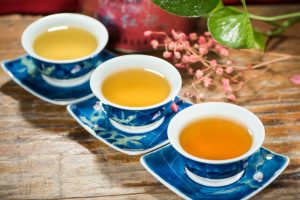Black tea looks very different from green tea because of its oxidation process.
Let’s take a look at this from a chemical point of view.
Polyphenols are compounds naturally found in plants. The name comes from the fact that they are made of many phenol structural units.
Catechins are a subset of polyphenols.
You’ve probably heard of EGCG, the most abundant catechin in green tea. It’s also responsible for many of green tea’s health benefits.
Through enzymatic oxidation, we obtain other polyphenols that aren’t naturally present in the tea plant.
Theaflavins
As the catechins oxidize, they form theaflavins through polymerization. In simple terms, small molecules are added to a larger chain to form a bigger molecule.
The major theaflavins in black and oolong tea are theaflavin-3-gallate, theaflavin-3′-gallate and theaflavin-3-3′-digallate.
Theaflavins have an orange color. From what I’ve read, a black tea with a high level of theaflavins is often of good quality.
Thearubigins
Theaflavins can be further oxidized, resulting in more highly polymerized molecules named thearubigins.
These compounds have a red color and are quite complex. They make up to 60% of dry weight of a black tea infusion.
Theabrownins
This term doesn’t appear as often, I guess it could be considered a subset of thearubigins.
Theabrownins occur through further oxidation, and as their name implies they have a brown color.
In black tea they aren’t so appreciated, but they are important in dark tea.
These three compounds are responsible not only for color, they also play a role in the aroma and taste of black tea, oolong tea and dark tea.
As a final note, catechin levels are much lower in these teas than in green tea.
Sources:
Effects of Variety, Season, and Region on Theaflavins Content of Fermented Chinese Congou Black Tea

